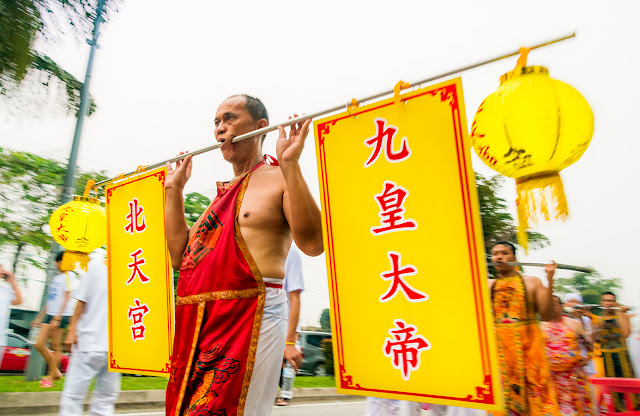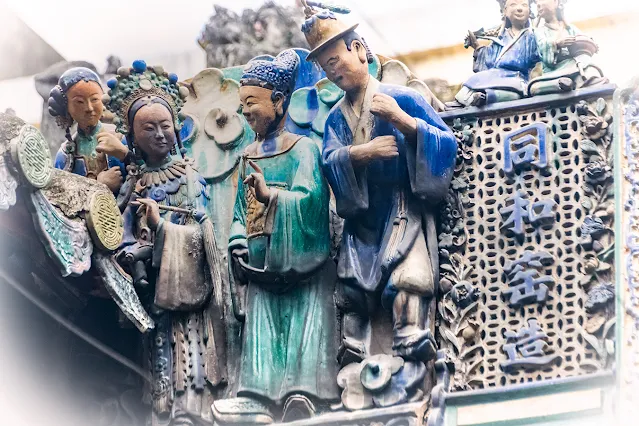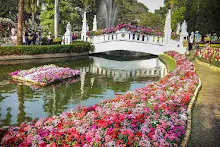A photoblog of stories, events, culture and travel. Let the images tell you what I see.
Wednesday, October 02, 2019
Faces of Nine Emperor Gods Festival Jinjang - the Priest
Tuesday, September 24, 2019
Let the spirits descend - the Nine Emperor Gods Festival 2019
The Nine Emperor Gods festival, which is starting is 5 days time, is associated with spirit mediums and trances of various deities including those of the Nine Emperor Gods. With these trances, acts of self mortification such as blood letting and body piercing are signs that the divine has taken over the body of the medium and that he or she does not feel any pain. Furthermore the blood letting is also both a sacrifice and purification of the space and surroundings, and thus is often carried out with great spiritual fervor. So let the spirits descend....
Where (can I see this festival): Nine Emperor Gods temples in South East Asia
For those who are looking for the schedule of events at Ampang Nine Emperor Gods Festival, surf over to Cheryl's post in her site - Haze Move over! Dates for the 2019 Festival (Ampang Style) for the schedule and lots more info regarding the festival.
Monday, September 23, 2019
Ready to sek zhai (吃斋/gin je)? The Nine Emperor Gods Festival 2019
Conversely, after nine days of festivities, the flag pole and the armies of heavenly guardians called to protect the temple and devotees during the festival would be sent off on the tenth day of the festival, one day after the last day of the Nine Emperor Gods festival.
This year the first day of the festival falls on 29 September 2019 and the ninth day falls on the 7 October 2019. The most obvious signs that a temple is celebrating the festival are temple flags being erected on roads leading to the temple grounds as well as vegetarian food stalls being erected. These stalls that sell suitable bland vegetarian food are usually marked with yellow banners displaying the word zhai/斋 or su/素; or in Southern Thailand, je/เจ.
- When (does it start): 29th Sept 2019 to 7th October 2019 (the eve falls on 28th Sept)
- Where (can I see this festival): Nine Emperor Gods temples in South East Asia
- What (to do): Eat vegetarian, see mediums perform rituals, watch parades, fire walking etc.
Thursday, February 14, 2019
Lighting Up Kek Lok Si Temple for Chinese New Year
 |
| The lights of Kek Lok Si Temple in the blue hour during Chinese New Year |
The lights of the temple will come on with the following schedule:
- January 24 to February 8 2019 : 7.30pm till midnight
- February 9 to February 21 2019: 7.30pm till 10pm
In my opinion, the best times are during the blue hour, which last only 15min or so, plus at that time, the lights are just being turned on in stages, so you will probably have at most 10 mins to shoot the lights in the blue hour. It is best to go before dark and sort of scout out which angle you prefer, and you might need to go on several occasions to get a good sky. I was lucky to get some clouds this time around.
Friday, January 11, 2019
Colourful Festivals of Malaysia - Thaipusam
 |
| A female devotee rolling on the ground until the steps of the caves as part of her penance. Helping her along the way are her family members. |
In Penang, there are many locations where the devotees are pierced. The market area of Lorong Kulit (behind the city stadium) is where the large kavadis are placed onto the devotees and a good place to catch glimpses of those scary piercings.
Sunday, August 05, 2018
The View from Above - The Black Virgin Mountain
The Black Virgin Mountain or Núi Bà Đen in Tây Ninh Province of Vietnam is the highest peak in Southern Vietnam. The hill is actually an almost perfect cinder cone of an extinct volcano (which gives it its distinctive shape) and is a popular tourist spot. You can take the gondola up the hill and then opt to take the more exhilarating luge ride back down. The upper gondola station gives you a lovely view of the plains below.
 |
| View from the top station of the Núi Bà Đen gondola lift. |
Friday, August 03, 2018
Thursday, August 02, 2018
Timeless Charm of Bà Thiên Hậu (Thien Hau Temple) in Saigon
If you are in District 5 of of Saigon, do make it a point to see the Thien Hau Temple there. Officially known as Chùa Bà Thiên Hậu (Pagoda of the Lady Heaven Empress aka Mazu), the temple is quintessentially Chinese in architecture. Whilst there are many Mazu temples elsewhere around the world that are bigger, or more grand, this temple is unique as it has that old school charm typical of Chinese diaspora temples.
Look at the roof ceramic diorama, the altar decorations and setup, and donation slips being hung in the temple, and you get transported back in time to when the temple was possibly the grandest ever built at that time in that area and was the focal point of the Chinese community in Saigon. Indeed this is one of the many temples that carries the timeless charm of old Saigon, Vietnam.
Thursday, May 03, 2018
Nature's Revenge... The Forlorn Remains of Danushkodi's St Anthony Church
 |
| The front facade of the church ruins. |
Tuesday, February 06, 2018
The Colours of Spring... Chiang Mai Flower Festival
 |
| The colours of spring...tulips at Chiang Mai Flower Festival 2018 |
Sunday, March 26, 2017
Weaving by the Sea
 |
| Weaving by the sea - with a view of the seafront at Galle. |
 |
| Using strips of the coconut spathe (flower stalk sheath) as twine to bind the basket. |
Wednesday, March 15, 2017
Everlasting Flower Lady of Ooty

Sunday, February 26, 2017
I Feel Pretty...
 |
| Shot at 38mm, ƒ/6.3, 1/40s, ISO 1000 with a Nikon D5300 and Tamron AF 18-270mm F3.5-6.3 Di II VC PZD lens. |
Saturday, February 04, 2017
Divine prediction... Fire Watching at Penang Ban Ka Lan Snake Temple
 |
| Getting them lit... Devotees throng to the Snake Temple to offer joss-sticks and candles on the eve of Chor Soo Kong's birthday. |
 |
| Deep in prayer...the never ending flow of devotees that come to pray to Chor Soo Kong on the eve of his birthday. |
As midnight approaches, an entourage will arrive with Taoist priest and a censer burner on a wooden carrier that will be placed in front of the deity on the main altar. After a short ceremony, joss sticks will be lit and passed to the committee members of the temple. These joss-sticks are then collected back after the members have offered their prayers and the tops snapped off and placed into the censer. The celebrant will then start the fanning until the embers burst into flames. The intensity, height and durability of this flame that is used as a prediction of Penang's quarterly economic state. This process will then be repeated two more times to obtain the prediction for the entire year.
When all three flames have been observed, the celebrant adds a sandalwood block and powder, and all present will rush forward to be blessed by the sandalwood smoke from the burner. When all inside have had their 'blessings', the censer and the carrier are taken out of the temple. There will then be other Chor Soo Kong temples who will also come with their censer in a carrier basket and perform the fire watching ceremony, which is usually used to predict their member's or organisation's luck in the coming year (as opposed to the entire state of Penang in the first one).
 |
| Flames that predict the economic well-being of Penang... the fire watching ceremony of Penang Snake Temple. |
Monday, January 30, 2017
Coming up - Thaipusam 2017
Vel! Vel! Veeravel! Vel! Vel! Vetrivel!
Son: Ooo, magic Vel (spear)!
Mother: Yes dear, now go play outside, don't make a mess in here...
Son: Can I go play (beat up) with the (bad) kid next door, Soorapadman? Please, please?
Mother: Ughhh... just play nice, OK?
Son: Okay Mommy (YES! I am so gonna split him in half)
Thursday, December 01, 2016
Scenes from Kashmir - Row row row your boat...
 |
| Row, row, row your boat... |
Wednesday, November 30, 2016
Kashmir - of Kangri pots, Pheran cloaks, and the men and women who use them
 |
| The Kangri or wicker basket brazier / fire-pot. |
 |
| A Kashmiri men in pheran with his kangri by the rodside near him (by the green post). |
 |
| They are NOT pregnant - they are just keeping their pots in there. These women in pheran seemed to carry their pots a little higher that the men do. |
 |
| No, she is not handicapped and definitely not pregnant! She is merely holding the kangri with her right hand. |
 |
| The water bong and a kangri - all that a man would need in Kashmir. |
 |
| The fire-pot man in Pahalgam - see this post about him: Faces of Kashmir - The Fire-Pot Man |
 |
| The women of the family are responsible for the hard work of bringing in the firewood for the charcoals. |
Tuesday, November 29, 2016
Faces of Kashmir - The Fire-Pot Man

See this post as well regarding the Kangri in Kashmir - of Kangri pots, Pheran cloaks, and the men and women who use them.




















